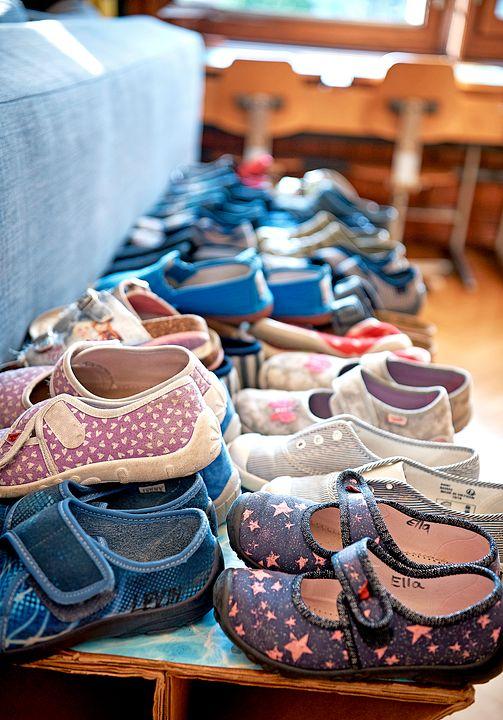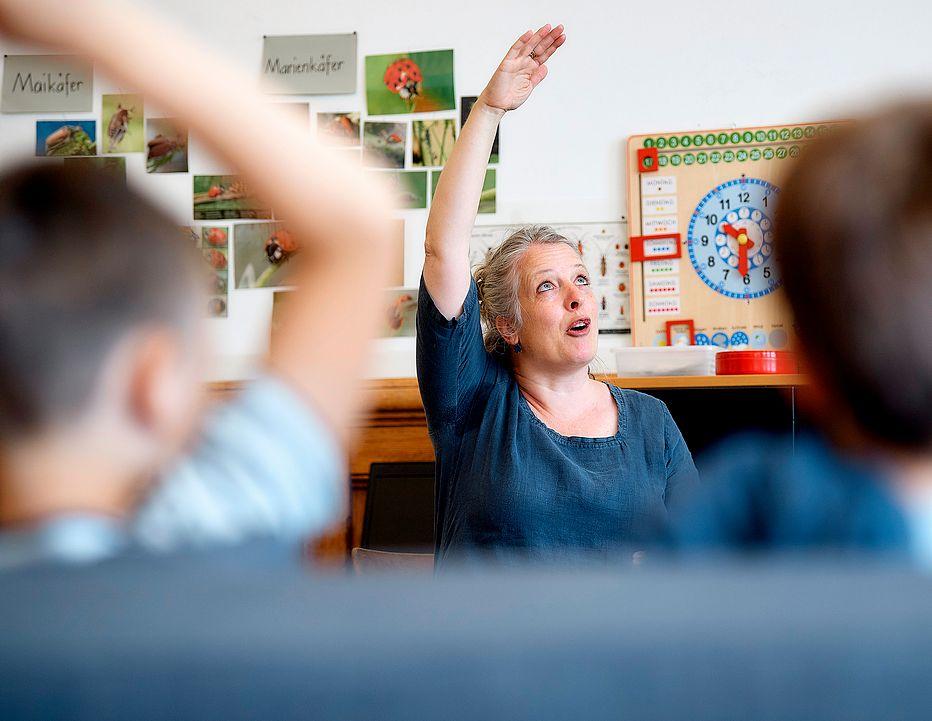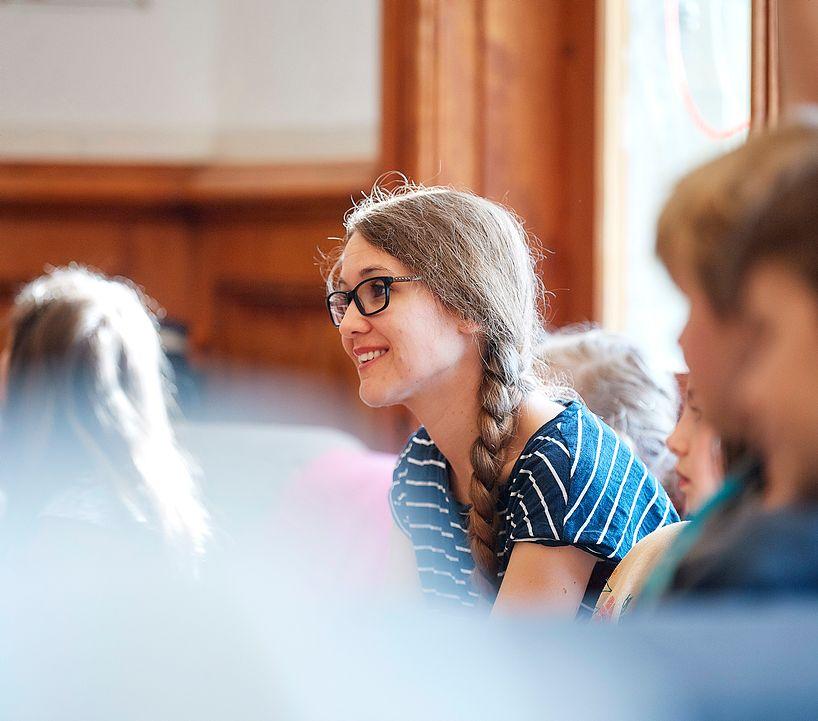
A fundamental change in Swiss schoolrooms

The face of Swiss primary schools is changing. New teaching methods are now part of the daily routine. The basic concept of school itself is changing – “skills” rather than knowledge are being increasingly taught. And women are more frequently the ones doing the teaching.
The windows of the schoolroom are wide open on this sunny morning. The air is still cool and the mood is relaxed. Here in Room 204 of the Spitalacker Primary School in Bern, teachers Danielle Baumann and Marie-Theres Moser are making the final preparations for the lesson prior to the arrival of their pupils aged six to eight.
A total of 700 children attend the Spitalacker Primary School. Twenty-four of them – first- and second-year pupils – make up the class of Danielle Baumann and Marie-Theres Moser. It is quite cosy, this small, neat schoolroom. And yet even here the really big changes in the Swiss school system can be seen.
The two teachers are teaching together this morning. “We enjoy team-teaching. It gives us more time for the individual children,” says Marie-Theres Moser. Otherwise, the two teachers work alternately. Both work part-time. Their profile is typical. For 75 percent of all teachers in primary schools in Switzerland are women. And some 70 percent of all primary school teachers work part-time.

The men who still teach in primary schools do so mostly in the seventh- to ninth-year classes – or they are employed as the school principal. That is in strong contrast to the past because for a long time the teaching profession in Switzerland was purely a job for men. In 1964 the proportion of men working in primary schools dropped for the first time to below 50 percent. Since then the proportion of women has grown steadily. The teaching profession is becoming ever more female.
Without women, standstill would threaten
Beat Zemp, president of the Swiss Teachers’ Association, is concerned about this trend. He would find “mixed-gender teams” better. “School, after all, is not just subjects; it should form pupils in mind, body and spirit. I am convinced that mixed-gender teams can more strongly support this holistic education,” he says.
At the same time, Zemp is very happy about the many women teaching: “Without women, the Swiss school system would be at a standstill.” The lack of teachers is acute and will only get worse because many will soon be retiring while the number of pupils is growing, says Zemp.
That the lack of teachers will become even more dramatic is something feared also by Martin Schäfer, rector of the University of Teacher Education Bern: “Someday here in Switzerland we will probably have to ask ourselves where we can find enough well-trained teachers.” The fact that it is mainly women teaching in primary schools does not bother Schäfer. In terms of professional skills they are in no way inferior to men, he says.
Association wants to raise quota of men
The profession today draws women mainly because of the good work-life balance, says Ron Halbright, chairman of the Men in Primary Schools project. “In Switzerland men and women often divide career and family work between themselves the ‘traditional’ way. Fathers are more likely to be the main breadwinner, mothers work part-time,” says Halbright.
The feminisation of the teaching profession damages its reputation, though, Halbright argues – wages have dropped, something that keeps men from taking up the profession. Today’s profile leads many men to believe that working with children is basically a woman’s thing. “They realise only at a late stage that they would also have been suitable for it.”
Despite the difficulties, Halbright’s association has set itself the goal of working toward a quota of men in primary schools of at least 30 percent – all across Switzerland.
Lessons in a “learning environment”
Far removed from this discussion, the two schoolchildren Emanuel and Yael are experiencing everyday life in Bern’s Spitalacker School. They enjoy going to school and like both their teachers. The fact that they like going to school is not just because of their two teachers as persons, but also because of their way of teaching.
Yael is lying on the sofa in the schoolroom reading, while Emanuel works on the calculation triangle. Both think it is great that they are free to choose from certain tasks and do not necessarily have to do the same thing at the same time. The blackboard is no longer the focal point of lesson practice. For that, the schoolroom has been transformed into a “learning environment” with a variety of workstations.

The Chur model – such is the name of the teaching model that Danielle Baumann and Marie-Theres Moser use in their lessons – is a teaching model that is currently sweeping Switzerland. In Chur, where it was developed, 40 classes already work with it. Reto Thöny, former school principal and father of the model, has been travelling across German-speaking Switzerland for some five years to present his learning approach. Meanwhile, schools in French-speaking Switzerland are also using his method. “It just hasn’t caught on in Ticino yet,” says Thöny.
In the Chur model, lessons often begin – as in kindergarten – with a brief input in a circle. Here the class is introduced to new topics and learning tasks are presented. The input, however, is kept purposely short – it should not reduce the time the pupils have for learning, time that they may use very independently.
One who is little surprised by the spread of the Chur model is Peter Lienhard, professor at the Zurich Training College for Teachers of Special Needs. The model is the basis for many key developments in today’s schools, he says. The essential thing is “to promote pupils individually according to their skills and abilities”. At the same time, school today has to include children with learning difficulties and disabilities. “Using the Chur model, one can react to those challenges in a better, more relaxed way,” he says.
New curriculum, new basic concept
The success of the Chur model is also due to the fact that the basic concept of teaching and learning is changing in Switzerland. The new Lehrplan 21 (Curriculum 21), valid for German-speaking Switzerland, as well as the French-speaking part’s Plan d’études romand, specify not only the content to be learned – great importance is given also to the skills the pupils are to acquire. Learning strategies and problem solving are moving much more into the focus of the lesson.
With the new curriculum, the schools of today will be competent to react to the rapid changes in the world, says Matthias Gubler. He is a psychologist and head of the Institut Unterstrass in Zurich that trains kindergarten and primary school teachers. Gubler says, “For acquiring knowledge alone there is no need to go to school these days, there are enough learning tools available in the internet for that. One will go to school in future to acquire skills that can be carried over later into one’s professional life and to be able to work with others together on a joint topic.”
The aim is to prepare the pupils of today for future tasks yet unknown in the society of tomorrow. “We still have a school that was created for the industrialised society of the last century,” says Gubler. School will continue to change, he says. The new curriculum and the spread of the new teaching model are just the first steps of that change.
Looking forward – to the break
In Room No. 204 of the Spitalacker School in Bern, there will be many changes in the years to come. The next big step is already coming up in two years: all kindergarten and primary school children between the ages of four and eight will be taught in so-called basic-level classes.
Classes will be formed in which children of both years of kindergarten plus the first- and second-year classes will go to school together. In this way the playing aspect of kindergarten and the scholastic aspect of the first primary school years will be mixed together. “That is a challenge that we are looking forward to,” says teacher Danielle Baumann. The change will not affect Yael and Emanuel, though. They will no longer be in the class. But they are still here and are now looking forward to the break.
This article was published on September 21, 2018 in Swiss RevueExternal link, the magazine for the Swiss Abroad. The author is a freelance journalist, specialised in educational issues.

In compliance with the JTI standards
More: SWI swissinfo.ch certified by the Journalism Trust Initiative































You can find an overview of ongoing debates with our journalists here . Please join us!
If you want to start a conversation about a topic raised in this article or want to report factual errors, email us at english@swissinfo.ch.